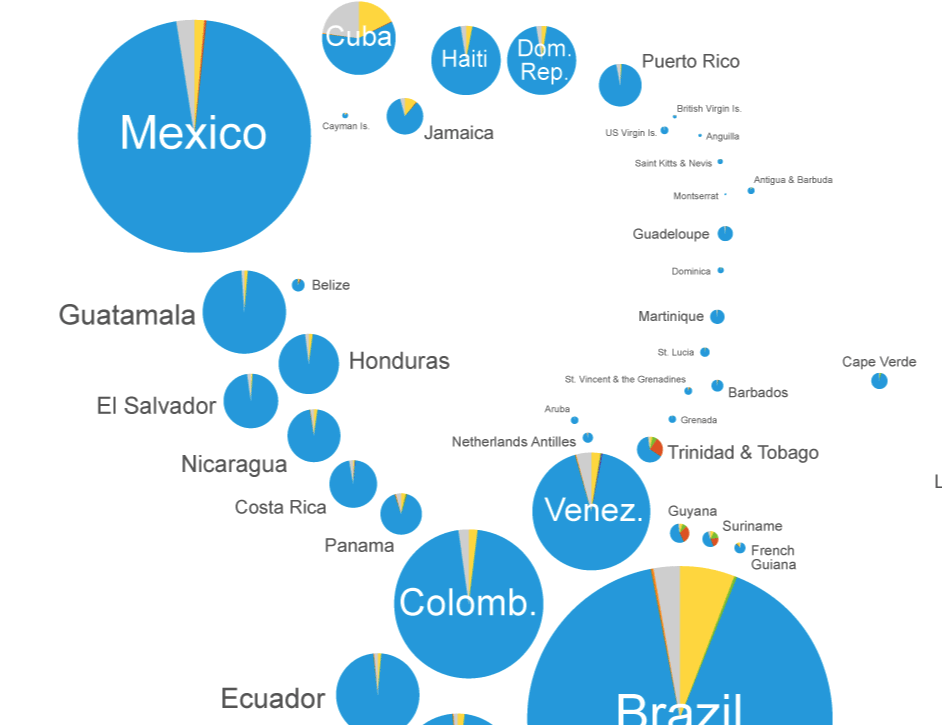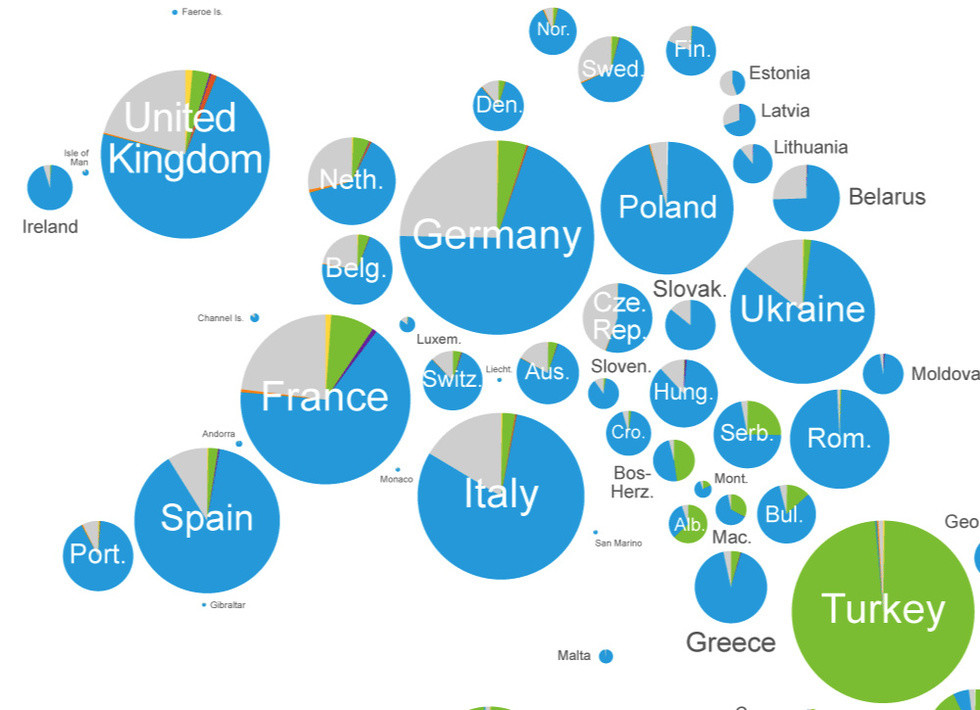These are all the world's major religions in one map

Devotees try to form a human pyramid to break a clay pot, to mark the Hindu festival of Janmashtami in Mumbai Image: REUTERS/Danish Siddiqui
- At a glance, this map shows both the size and distribution of world religions.
- See how religions mix at both national and regional level.
- There's one country in the Americas without a Christian majority – which?


A picture says more than a thousand words, and that goes for this world map as well. This map conveys not just the size but also the distribution of world religions, at both a global and national level.
Strictly speaking it's an infographic rather than a map, but you get the idea. The circles represent countries, their varying sizes reflect population sizes, and the slices in each circle indicate religious affiliation.
The result is both panoramic and detailed. In other words, this is the best, simplest map of world religions ever. Some quick takeaways:
- Christianity (blue) dominates in the Americas, Europe and the southern half of Africa.
- Islam (green) is the top religion in a string of countries from northern Africa through the Middle East to Indonesia.
- India stands out as a huge Hindu bloc (dark orange).
- Buddhism (light orange) is the majority religion in South East Asia and Japan.
- China is the country with the world's largest 'atheist/agnostic' population (grey) as well as worshippers of 'other' religions (yellow).
- The Americas are (mostly) solidly Christian

But the map – based on figures from the World Religion Database (behind a paywall) – also allows for some more detailed observations.
- Yes, the United States is majority Christian, but the atheist/agnostic share of its population alone is bigger than the total population of most other countries, in the Americas and elsewhere. Uruguay has the highest share of atheists/agnostics in the Americas. Other countries with a lot of 'grey' in their pies include Canada, Cuba, Argentina and Chile.
- All belief systems represented on the scale below are present in the US and Canada. Most other countries in the Americas are more mono-religiously Christian, with 'other' (often syncretic folk religions such as Candomblé in Brazil or Santería in Cuba) the only main alternative.
- Guyana, Suriname and Trinidad & Tobago are the only American nations with significant shares of Hindus, as well as the largest share of Muslim populations – and consequently have the lowest share of Christians in the Americas (just under half in the case of Suriname).

- Christianity is still the biggest belief system in most European countries, but the atheist/agnostic share is strong in many places, mainly in Western Europe, but especially in the Czech Republic, where it is close to half the total.
- Islam represents a significant slice (and a large absolute number) in France, Germany and the UK, and is stronger in the Balkans: The majority in Albania, almost half in Bosnia and around a quarter in Serbia (although that probably indicates the de facto independent province of Kosovo).

- Israel is the world's only majority-Jewish state (75%, with 18% Muslim). The West Bank, shown separate, also has a significant Jewish presence (20%, with 80% Muslim). Counted as one country, the Jewish majority would drop to around 55%.
- Strictly Islamic Saudi Arabia, but also some of its neighbors in the Gulf, have significant non-Muslim populations – virtually all guest workers and ex-pats.
- Nigeria, due to its large population and even split between Islam and Christianity, has more Muslims and more Christians than most other African nations.

- Because countries are sized for population rather than area, some are much bigger or smaller than you'd expect – with some interesting results: There are more Christians in Muslim-majority Indonesia than there are in mainly Christian Australia, for example.
- Hindus are a minority everywhere outside India, except in Nepal.
- North Korea is shown as three-quarters atheist/agnostic, but this is debatable, on two counts. In what is often referred to as the last Stalinist state on Earth, religious adherence is probably underreported. And the state-sponsored ideology of 'Juche', although in essence based on materialism, makes some supernatural claims. For instance: despite having died in 1994, Kim Il-sung was declared 'president for eternity' in 1998.
Of course, clarity comes at the cost of detail. The map bands together various Christian and Islamic schools of thought that don't necessarily accept each other as 'true believers'. It includes Judaism (only 15 million adherents, but the older sibling of the two largest religious groups) yet groups Sikhism (27 million) and various other more numerous faiths in with 'others'. And it doesn't make the distinction between atheism ("There is no god") with agnosticism ("There may or may not be a god, we just don't know").
And then there's the whole minefield of nuance between those who practice a religion (but may do so out of social coercion rather than personally held belief), and those who believe in something (but don't participate in the rituals of any particular faith). To be fair, that requires more nuance than even a great map like this can probably provide.
Don't miss any update on this topic
Create a free account and access your personalized content collection with our latest publications and analyses.
License and Republishing
World Economic Forum articles may be republished in accordance with the Creative Commons Attribution-NonCommercial-NoDerivatives 4.0 International Public License, and in accordance with our Terms of Use.
The views expressed in this article are those of the author alone and not the World Economic Forum.
Stay up to date:
Roles of Religion
Related topics:
Forum Stories newsletter
Bringing you weekly curated insights and analysis on the global issues that matter.






